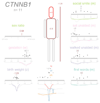Clinical features associated with CTNNB1 de novo loss of function mutations in ten individuals
- PMID: 27915094
- PMCID: PMC6070129
- DOI: 10.1016/j.ejmg.2016.11.008
Clinical features associated with CTNNB1 de novo loss of function mutations in ten individuals
Abstract
Loss of function mutations in CTNNB1 have been reported in individuals with intellectual disability [MIM #615075] associated with peripheral spasticity, microcephaly and central hypotonia, suggesting a recognisable phenotype associated with haploinsufficiency for this gene. Trio based whole exome sequencing via the Deciphering Developmental Disorders (DDD) study has identified eleven further individuals with de novo loss of function mutations in CTNNB1. Here we report detailed phenotypic information on ten of these. We confirm the features that have been previously described and further delineate the skin and hair findings, including fair skin and fair and sparse hair with unusual patterning.
Keywords: CTNNB1; Intellectual disability; Microcephaly.
Copyright © 2016 Elsevier Masson SAS. All rights reserved.
Figures


Similar articles
-
A new intellectual disability syndrome caused by CTNNB1 haploinsufficiency.Am J Med Genet A. 2014 Jun;164A(6):1571-5. doi: 10.1002/ajmg.a.36484. Epub 2014 Mar 25. Am J Med Genet A. 2014. PMID: 24668549
-
De novo mutations in beta-catenin (CTNNB1) appear to be a frequent cause of intellectual disability: expanding the mutational and clinical spectrum.Hum Genet. 2015 Jan;134(1):97-109. doi: 10.1007/s00439-014-1498-1. Epub 2014 Oct 19. Hum Genet. 2015. PMID: 25326669
-
A de novo CTNNB1 nonsense mutation associated with syndromic atypical hyperekplexia, microcephaly and intellectual disability: a case report.BMC Neurol. 2016 Mar 12;16:35. doi: 10.1186/s12883-016-0554-y. BMC Neurol. 2016. PMID: 26968164 Free PMC article.
-
Exome sequencing identifies a de novo mutation of CTNNB1 gene in a patient mainly presented with retinal detachment, lens and vitreous opacities, microcephaly, and developmental delay: Case report and literature review.Medicine (Baltimore). 2017 May;96(20):e6914. doi: 10.1097/MD.0000000000006914. Medicine (Baltimore). 2017. PMID: 28514307 Free PMC article. Review.
-
Delineating the phenotypic spectrum of Bainbridge-Ropers syndrome: 12 new patients with de novo, heterozygous, loss-of-function mutations in ASXL3 and review of published literature.J Med Genet. 2017 Aug;54(8):537-543. doi: 10.1136/jmedgenet-2016-104360. Epub 2017 Jan 18. J Med Genet. 2017. PMID: 28100473 Review.
Cited by
-
Defects in the Cell Signaling Mediator β-Catenin Cause the Retinal Vascular Condition FEVR.Am J Hum Genet. 2017 Jun 1;100(6):960-968. doi: 10.1016/j.ajhg.2017.05.001. Am J Hum Genet. 2017. PMID: 28575650 Free PMC article.
-
A de novo CTNNB1 Novel Splice Variant in an Adult Female with Severe Intellectual Disability.Int Med Case Rep J. 2020 Oct 7;13:487-492. doi: 10.2147/IMCRJ.S270487. eCollection 2020. Int Med Case Rep J. 2020. PMID: 33116939 Free PMC article.
-
Skeletal abnormalities, pediatric-onset severe osteoporosis, and multiple fragility fractures in a patient with a novel CTNNB1 de novo variant.Bone Rep. 2024 Jun 4;21:101777. doi: 10.1016/j.bonr.2024.101777. eCollection 2024 Jun. Bone Rep. 2024. PMID: 38952406 Free PMC article.
-
CTNNB1-related neurodevelopmental disorder mimics cerebral palsy: case report.Front Pediatr. 2023 Jun 16;11:1201080. doi: 10.3389/fped.2023.1201080. eCollection 2023. Front Pediatr. 2023. PMID: 37416820 Free PMC article.
-
CTNNB1 in neurodevelopmental disorders.Front Psychiatry. 2023 Mar 16;14:1143328. doi: 10.3389/fpsyt.2023.1143328. eCollection 2023. Front Psychiatry. 2023. PMID: 37009120 Free PMC article. Review.
References
-
- Brault V, Moore R, Kutsch S, Ishibashi M, Rowitch DH, McMahon AP, Sommer L, Boussadia O, Kemler R. Inactivation of the beta-catenin gene by Wnt1-Cre-mediated deletion results in dramatic brain malformation and failure of craniofacial development. Development. 2001 Apr;128(8):1253–64. - PubMed
-
- de Ligt J, Willemsen MH, van Bon BW, Kleefstra T, Yntema HG, Kroes T, Vulto-van Silfhout AT, Koolen DA, de Vries P, Gilissen C, del Rosario M, et al. Diagnostic exome sequencing in persons with severe intellectual disability. N Engl J Med. 2012 Nov 15;367(20):1921–9. - PubMed
-
- Dubruc E, Putoux A, Labalme A, Rougeot C, Sanlaville D, Edery P. A new intellectual disability syndrome caused by CTNNB1 haploinsufficiency. Am J Med Genet A. 2014 Jun;164A(6):1571–5. - PubMed
-
- Huelsken J, Vogel R, Erdmann B, Cotsarelis G, Birchmeier W. Beta-Catenin controls hair follicle morphogenesis and stem cell differentiation in the skin. Cell. 2001 May 18;105(4):533–45. - PubMed
MeSH terms
Substances
Grants and funding
LinkOut - more resources
Full Text Sources
Other Literature Sources
Medical
Molecular Biology Databases
Research Materials
Miscellaneous

